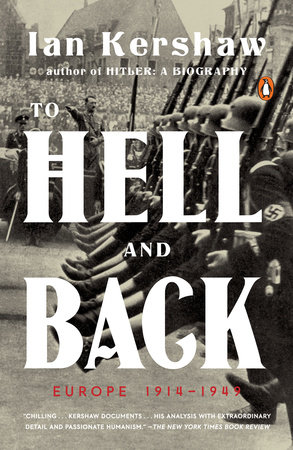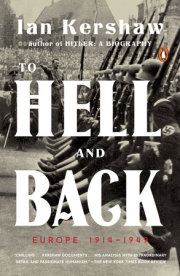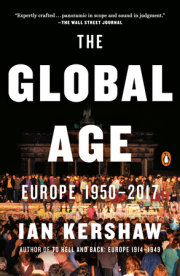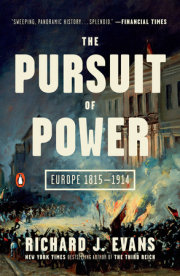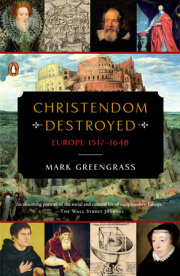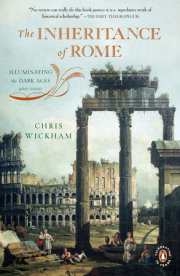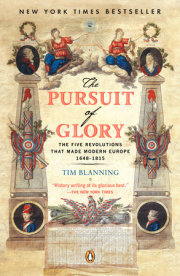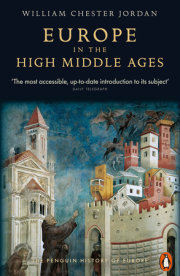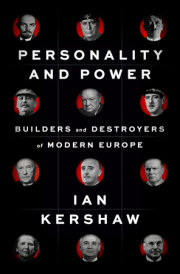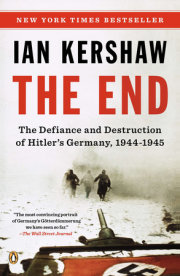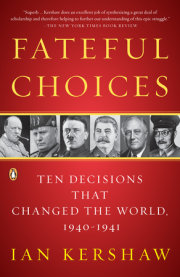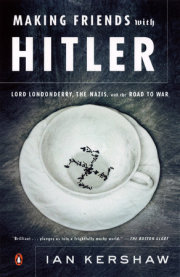Preface
This is the first of two volumes on the history of Europe from 1914 to our own times. It is by some distance the hardest book I have undertaken. Each book I have written has in some sense been an attempt to gain a better understanding on my part of a problem in the past. In this case, the recent past contains a multiplicity of extremely complex problems. But whatever the difficulties, the temptation to try to understand better the forces that have in the recent past shaped the world of today was irresistible.
There is, of course, no single way to approach a history of the twentieth century in Europe. Some excellent histories with varying interpretations and structures – among them, each with a different slant on the century, the works of Eric Hobsbawm, Mark Mazower, Richard Vinen, Harold James and Bernard Wasserstein – already exist. This volume and the one to follow it necessarily represent a personalized approach to such a momentous century. And like every attempt to cover a vast panorama over a lengthy time span, it has to rely heavily upon the pioneering research of others.
I am more than conscious of the fact that for practically every sentence I wrote a plethora of specialist works, often of great quality, was available. Only for a few aspects, mainly relating to Germany between 1918 and 1945, can I claim to have carried out primary research. Elsewhere, I have had to depend upon the excellent work of other scholars in many different fields. Even with greater linguistic competence than I possess this would have been inevitable. No single scholar could possibly carry out archival work throughout Europe, and, since invariably experts on particular countries and on specific historical themes have already done such work, the attempt would be pointless anyway. Such an overview as I am presenting has, therefore, to rest on the countless achievements of others.
The format of the Penguin History of Europe series precludes references to the many indispensable works of historical scholarship – monographs, editions of contemporary documentation, statistical analyses, and specialized studies of individual countries – on which I have relied. The bibliography reflects some of my more important debts to other scholars. I hope they will forgive the inability to refer to their works in footnotes, and will accept my deep appreciation of their great endeavours. Any originality rests, therefore, solely on structure and interpretation – how the history is written and the underlying nature of the argument.
The introduction, ‘Europe’s Era of Self-Destruction’, lays out the framework of interpretation of this volume as well as indicating the approach to the second volume (yet to be written). As regards the structure, I have organized the chapters that follow chronologically with thematic sub-divisions. This reflects my concern to pay particular attention to precisely how the drama unfolded, and to the specific shaping of events by concentrating on fairly short periods while necessarily dealing separately within those periods with the differing formative forces. So there are no chapters devoted expressly to the economy, society, culture, ideology or politics, though these find their place, if not necessarily with equal weight, within individual chapters.
The first half of the twentieth century, the subject of this volume, was dominated by war. This raises its own problems. How is it possible to deal with the vast and momentous topics of the First and Second World Wars within such a wide-ranging volume as this? Whole libraries of works exist on both conflicts. But readers may justifiably be expected not simply to be referred to other works (though naturally these can be followed up on every theme of the volume). So I thought it worthwhile to begin the chapters relating directly to the two world wars with extremely concise surveys of the developments on the fronts. However tersely described – largely for orientation, and to highlight in the briefest terms the scale of the calamities that determined the immensity of their consequences – it is obvious that these events were crucial. In other instances, too, I pondered whether to take for granted that all readers would be well acquainted with, for example, the background to the rise of fascism in Italy or to the course of the Spanish Civil War, before deciding that, again, brief surveys might prove useful.
Throughout, I have been anxious to blend in personal experiences of contemporaries to give an indication of what it was like to live through this era, so near in time yet so different in nature to present- day Europe. Of course, I recognize that personal experience is just that. It cannot be taken as statistically representative. But it can often be seen as indicative – reflective of wider attitudes and mentalities. In any case, the inclusion of personal experiences provides vivid snapshots and gives a flavour, detached from abstractions and impersonal analysis, of how people reacted to the mighty forces that were buffeting their lives.
A history of Europe cannot, of course, be a sum of national histories. What is at stake are the driving forces that shaped the continent as a whole in all or at least most of its constituent parts. A general synthesis has naturally to offer a bird’s-eye rather than a worm’s-eye view. It has to generalize, not concentrate on peculiarities, though unique developments only in fact become visible through a wide lens. I have tried not to ignore any areas of Europe, and often to emphasize the specially tragic history of the eastern half of the continent. But inevitably, some countries played a greater (or more baleful) role than others and correspondingly warrant more attention. Europe in this volume and the next is taken to include Russia (then the Soviet Union); it would be unthinkable to leave out such a crucial player in European history, even if extensive parts of the Russian, then Soviet, Empire lay geographically outside Europe. Similarly, Turkey is included where it was significantly involved in European affairs, though this sharply diminished after 1923 once the Ottoman Empire had broken up and the Turkish nation state had been established.
This volume begins with a brief overview of Europe on the eve of the First World War. Chapters then follow on the war itself, its immediate aftermath, the short-lived recovery in the mid-1920s, the searing impact of the Great Depression, the looming threat of another world war, the unleashing of a further great conflagration within a generation, and the devastating collapse of civilization that this Second World War produced. At this point I interrupt the chronological structure with a thematic chapter (Chapter 9), which explores a number of long-term thematic developments that cross the short-term chronological boundaries of earlier chapters – demographic and socio-economic change, the position of the Christian Churches, the stance of intellectuals and the growth of popular entertainment. A concluding chapter returns to a chronological framework.
I had thought of ending this first volume in 1945, when the actual fighting in the Second World War stopped. But, though formal hostilities in Europe ceased in May of that year (continuing until August against Japan), the fateful course of the years 1945–9 was so plainly determined by the war itself, and reactions to it, that I thought it justifiable to look beyond the moment when peace officially returned to the continent. The contours of a new, post-war Europe were scarcely visible in 1945; they only gradually came clearly into view. It seemed to me, therefore, appropriate to add a final chapter dealing with the immediate aftermath of the war, which not only saw a period of continuing violence but also indelibly shaped the divided Europe that had emerged by 1949. So the first volume ends not in 1945, but in 1949.
One of the most beloved clichés of football commentators, when the half-time interval has brought a remarkable change of fortunes, is: ‘It’s a game of two halves.’ It is very tempting to think of Europe’s twentieth century as a century of two halves, perhaps with ‘extra time’ added on after 1990. This volume deals only with the first half of an extraordinary and dramatic century. This was the era in which Europe carried out two world wars, threatened the very foundations of civilization, and seemed hell-bent on self-destruction.
Ian Kershaw, Manchester, November 2014
Introduction: Europe’s Era of Self-Destruction
The wars of peoples will be more terrible than those of kings.
Winston Churchill (1901)
Europe’s twentieth century was a century of war. Two world wars followed by over forty years of ‘cold war’ – itself the direct product of the Second World War – defined the age. It was an extraordinarily dramatic, tragic and endlessly fascinating period, its history one of huge upheaval and astounding transformation. During the twentieth century, Europe went to hell and back. The continent, which for nearly one hundred years after the end of the Napoleonic Wars in 1815 had prided itself on being the apogee of civilization, fell between 1914 and 1945 into the pit of barbarism. But a calamitous self-destructive era was followed by previously unimaginable stability and prosperity – though at the heavy price of unbridgeable political division. Thereafter, a reunified Europe, facing huge internal pressures from intensified globalization and serious external challenges, experienced increasing inbuilt tensions even before the financial crash of 2008 plunged the continent into a new, still unresolved, crisis.
A second volume will explore the era after 1950. This first volume, however, looks at Europe’s near self-destruction in the first half of the century, during the era of the two world wars. It explores how the dangerous forces emanating from the First World War culminated in scarcely imaginable depths of inhumanity and destruction during the Second. This catastrophe, together with the unprecedented levels of genocide from which the conflict cannot be separated, makes the Second World War the epicentre and determining episode of Europe’s troubled history in the twentieth century.
The chapters that follow explore the reasons for this immeasurable catastrophe. They locate these in four interlocking major elements of comprehensive crisis, unique to these decades: (1) an explosion of ethnic-racist nationalism; (2) bitter and irreconcilable demands for territorial revisionism; (3) acute class conflict – now given concrete focus through the Bolshevik Revolution in Russia; and (4) a protracted crisis of capitalism (which many observers thought was terminal). Bolshevism’s triumph was a vital new component after 1917. So was the almost constant state of crisis of capitalism, alleviated for only a brief few years in the mid-1920s. The other elements had been present before 1914, though in far less acute form. None had been a primary cause of the First World War. But the new virulence of each was a crucial outcome of that war. Their lethal interaction now spawned an era of extraordinary violence, leading to a Second World War far more destructive even than the First. Worst affected from the interlinkage of the four elements were central, eastern and south-eastern Europe – for the most part the poorest regions of the continent. Western Europe fared better (though Spain was an important exception).
The disintegration of the Austro-Hungarian and Ottoman empires at the end of the First World War, and the immense violent upheavals of the Russian Civil War that followed directly on the Revolution, unleashed new forces of extreme nationalism in which identity with the nation was usually defined ethnically. Nationalist and ethnic conflict was especially endemic in the poorer eastern half of the continent – the regions of long-standing ethnically mixed communities. Often nationalist hatred singled out Jews as special scapegoats for resentment and social misery. There were more Jews in central and eastern than western Europe, and they were mainly less well integrated and of a lower social class than their co-religionists in west European countries. These central and east European regions, far more so than Germany, were the traditional heartlands of vicious antisemitism. The greater ethnic homogeneity that generally existed in western Europe, and the fact that its nation states had usually evolved over a lengthy period of time, meant that the tensions there, though not completely absent, were less great than to the east.
The victors and most of the neutral countries in the First World War were, moreover, to be found in western Europe. Damaged national prestige and competition for material resources, the feeding-ground for aggressive ethnic nationalism, played a much greater role farther east. In the centre of the continent, Germany, the most important defeated country and the key to Europe’s future peace, with borders stretching from France and Switzerland in the west to Poland and Lithuania in the east, harboured great resentment at its treatment by the victorious Allies and only temporarily quelled its revisionist ambitions. Further south and east, the ruins of the Austro-Hungarian, Russian and Ottoman empires gave birth to new nation states, often patched together in the least propitious circumstances imaginable. It is no surprise that the nationalist and ethnic hatreds that poisoned politics should make these regions the major killing-grounds of the Second World War.
Nationalist conflicts and ethnic-racial tensions were greatly intensified by the territorial settlement of Europe that followed the First World War. The architects of the Versailles Treaty in 1919, however good their intentions, faced insuperable problems in attempting to satisfy the territorial demands of the new countries formed out of the wreckage of the old empires. Ethnic minorities formed sizeable parts of most of the new states in central, eastern and south-eastern Europe, offering a potential base for serious political disturbance. Almost everywhere, borders were disputed and the demands of ethnic minorities, which usually faced discrimination from the majority population, were unresolved. These Versailles border reallocations moreover fostered dangerously simmering resentments in countries that felt themselves unfairly treated. Although Italy had no internal ethnic divisions (apart from the largely German-speaking population of South Tyrol, annexed after the end of the war), nationalists and fascists could exploit the sense of injustice that a country on the side of the victorious powers in the First World War should be deprived of the gains it aspired to in territory that would soon be called Yugoslavia. Far more dangerous for Europe’s lasting peace, the deep anger in Germany – like Italy, lacking internal ethnic divisions – at the truncation of territory after the war, and the demands for revision of the Versailles Treaty, later fed into the growing support for Nazism, and outside the Reich’s borders encouraged the resentment of German ethnic minorities in Poland, Czechoslovakia and elsewhere.
The shrill nationalism that emerged after the First World War gained momentum not just from ethnic rivalry but also from class conflict. A sense of national unity could be immeasurably sharpened by a focus on supposed class ‘enemies’ within and outside the nation state. The immense economic upheaval that followed the war and the dire consequences of the slump of the 1930s greatly intensified class antagonism throughout Europe. Class conflict, frequently violent, had of course punctuated the entire industrial era. But it was made far more acute, compared with the pre-war years, by the Russian Revolution and the establishment of the Soviet Union. This provided an alternative model of society, one that had overthrown capitalism and created a ‘dictatorship of the proletariat’. Elimination of the capitalist class, expropriation by the state of the means of production, and land redistribution on a massive scale were attractive propositions after 1917 for wide sections of the impoverished masses. But the presence of Soviet communism also split the political Left, fatally weakening it, at the same time as it hugely strengthened extreme nationalist right-wing forces. Revitalized elements from the Right could direct the violent energies of those who felt threatened by Bolshevism – in the main the traditional propertied elites, the middle classes and the landholding peasantry – into new, highly aggressive political movements.
Counter-revolution, like the revolutionary appeal on the Left, exploited the bitterness and anxieties of class conflict. Counter-revolutionary movements gained their most widespread appeal where they were able to combine extreme nationalism with virulent anti-Bolshevism. Again, countries in central and eastern Europe, where the Bolshevik threat was seen to loom large, were particularly affected. But the greatest international danger arose where the combination of extreme nationalism and almost paranoid hatred of Bolshevism gave succour to the creation of mass movements on the Right, which in Italy and then later in Germany were able to take over power in the state. When in these cases the hate-filled nationalist and anti-Bolshevik energies that had propelled the extreme Right to power could be channelled into external aggression, the peace of Europe stood in great jeopardy.
The fourth component, underpinning and interacting with the other three elements, was the lasting crisis of capitalism between the wars. The massive disturbance to the world economy caused by the First World War, the serious weakness of the major European economies of Britain, France and Germany, and the reluctance of the one outstanding economic power, the USA, to engage fully with European reconstruction, spelled disaster. Europe’s problems were compounded by the worldwide repercussions of the war. Japan expanded its markets in the Far East, not least in China – wracked by political chaos – at the expense of the Europeans. The British Empire faced mounting political as well as economic challenges, most obviously in India where the growth of an indigenous textile industry and consequent loss of export markets added to Britain’s economic woes. And Russia effectively disappeared from the world economy in the wake of revolution and civil war. Capitalism’s crisis was global, but especially damaging in Europe.
The inflationary crisis of the early 1920s and deflationary crisis of the 1930s bracketed an all too short-lived boom that proved to have been built on sand. The two phases, only briefly separated, of massive economic and social dislocation provided a climate in which both deprivation and fear of deprivation massively fuelled the political extremes.
Economic turmoil on its own was insufficient to produce major political upheaval. For that, the turmoil needed a crisis in the legitimacy of the state underpinned by an existing ideological schism and deep cultural divides that exposed weakened power-elites to new pressures from mass mobilization. Precisely such conditions were, however, present in many parts of Europe, especially where extreme integral nationalism, drawing on a wide-ranging sense of loss of national prestige and disappointed expectations of great-power status, could foster a strong movement that drew energy from the alleged strength of the diabolical enemies it claimed to face, and was in a position to challenge for power in a state with weak authority.
What was needed, therefore, to engender the comprehensive political, socio-economic and ideological-cultural crisis that brought Europe to the verge of self-destruction was the intermeshing of the four components of the crisis. In one degree or another, such interaction affected most European countries, even in western Europe. But in one country, especially – Germany – all four elements were present in their most extreme form, reinforcing each other with explosive effect. And when Adolf Hitler, exploiting the comprehensive crisis in masterly fashion and with ideas of overcoming it by use of force, was able to cement his dictatorial control over the German state, the odds on general catastrophe in Europe shortened markedly. Since Germany’s military as well as economic potential was so great (if temporarily diminished after the First World War) and since its revisionist claims and expansionist ambitions directly impinged upon the territorial integrity and political independence of so many other countries, the probability that Europe’s crisis would end in a cataclysmic new war became increasingly high. It was no surprise that the crisis would come to a head in central and eastern Europe, the most destabilized parts of the continent, nor that, once war had begun, the lands in the east would turn into the theatre of the greatest destruction and grotesque inhumanity.
The devastation of the Second World War plumbed new depths. The moral consequences of such a profound collapse of civilization would be felt for the rest of the century, and beyond. Yet, remarkably, the Second World War, in stark contrast to the mayhem engendered by the First, paved the way for Europe’s rebirth in the latter half of the century. Where the First World War had left behind a legacy of heightened ethnic, border and class conflict together with a deep and prolonged crisis of capitalism, the Second swept away this concatenation in its very maelstrom of destruction. The Soviet Union’s domination of eastern Europe forcibly suppressed internal ethnic divisions and unrest. The immediate post-war grand-scale ethnic cleansing reshaped the map of central and eastern Europe. Germany’s dreams of domination in Europe were extinguished in the country’s total defeat, devastation and division. There was a new readiness in western Europe to defuse nationalist antagonism in favour of cooperation and integration. Borders were now fixed by the presence of the new superpowers. The conversion into west European state ideologies of the earlier anti-Bolshevism that had bolstered the extreme Right fostered stable conservative politics. And not least the reformed capitalism (this time with an active lead provided by the USA) produced untold prosperity in the western half of the continent, thereby underpinning political stability. All these fundamental changes after 1945 combined to remove the matrix of crisis elements that had nearly destroyed the continent in the era of the two world wars.
Crucially, the Second World War broke once and for all the system of competing European great powers struggling for mastery of the continent, which stretched back beyond Bismarck’s era to the end of the Napoleonic era in 1815. In a reborn Europe, though a Europe now ideologically and politically riven, the only great powers left were the United States and the Soviet Union, glowering at each other across the Iron Curtain and presiding over the rebuilding of states and societies in their own image. There was a further vital element: once both superpowers possessed atomic bombs, as they did by 1949, and within four years even more horrifically destructive hydrogen bombs, the spectre of nuclear war threatened a level of destruction that would have left the devastation of both world wars in its shadow. That concentrated minds and played its own part in creating what, in 1945, seemed a highly unlikely era of peace in Europe.
• • •
How these elements interwove to transform Europe, east and west, remains to be explored in the next volume. What follows in this volume is an attempt to understand how Europe sank into the abyss during the first half of such a violent, turbulent century, but then, remarkably, already within four years of reaching rock-bottom in 1945, how it began to lay the platform for astonishing recovery – for a new Europe to emerge from the ashes of the old and to embark on the road back from hell on earth.
Copyright © Ian Kershaw. All rights reserved. No part of this excerpt may be reproduced or reprinted without permission in writing from the publisher.

